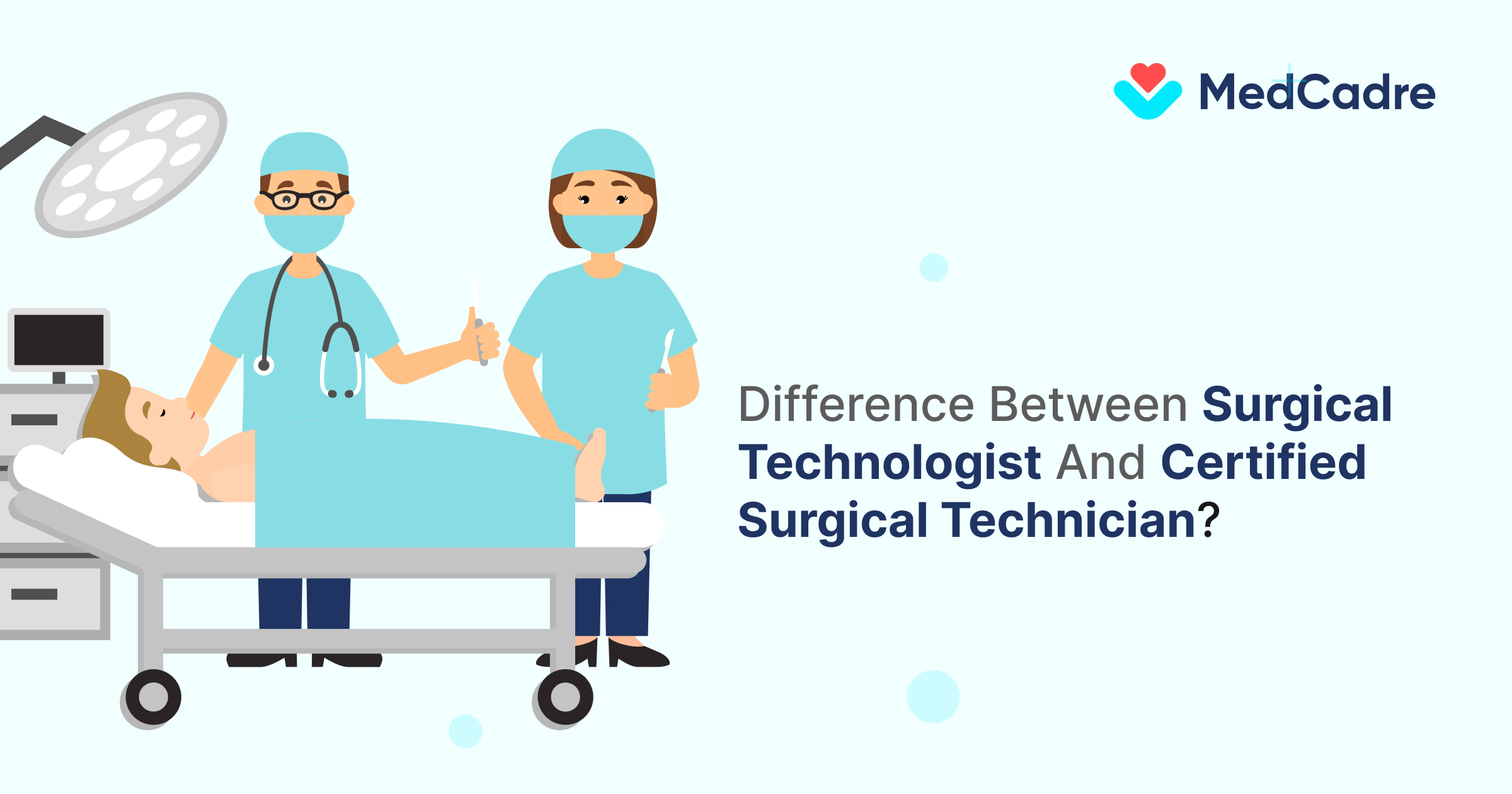Two roles that often come up in discussions around surgical teams are the Surgical surgical Technologist and the Certified Surgical Technician. While these titles might sound similar and are often used interchangeably, they represent distinct roles with specific responsibilities. This article delves into the differences between a surgical technology and a Certified Surgical Technician.
The difference between a surgical technologist and a certified surgical technician
1. Definition and scope of roles
Surgical technologist:
Surgical technology plays an integral role in the operating room (OR). Their primary responsibility revolves around ensuring that the OR is prepared for surgeries. This includes setting up instruments, equipment, and sterile drapes. They also assist surgeons during operations by passing instruments and supplies, holding retractors, and anticipating the surgeon’s needs. Post-surgery, they assist in dressing wounds and transferring patients to recovery rooms.
Certified surgical technician:
The title “Certified” denotes a higher level of qualification. A certified surgical technologist (CST) is a surgical technology who has earned professional certification after meeting specific educational and training requirements set by recognized certifying bodies, such as the National Board of Surgical Technology and Surgical Assisting (NBSTSA) in the USA. This certification ensures that the individual has undergone standardized training and has passed a rigorous examination.
2. Educational and training requirements
Surgical technologist:
To become a Surgical Technologist, individuals typically need to complete a post-secondary certificate or associate degree program. These programs, accredited by the Commission on Accreditation of Allied Health Education Programs (CAAHEP) or the Accrediting Bureau of Health Education Schools (ABHES), provide comprehensive training in surgical procedures, sterilization techniques, and patient care. Upon graduation, individuals can work as surgical technologists.
Certified surgical technician:
While the educational pathway for a Surgical Technologist and a Certified Surgical Technician might be similar, a CST has to meet additional requirements to earn certification. After completing their formal education, aspiring CSTs must pass the Certified Surgical Technologist exam administered by the NBSTSA. This exam evaluates their knowledge and skills in areas like preoperative care, intraoperative procedures, postoperative care, and sterile techniques. Only upon successfully passing this examination can they use the CST designation.
3. Professional recognition and advancement
Surgical technologist:
Surgical Technologists, although highly skilled, might not have the same level of recognition as their certified counterparts. However, their role remains critical in ensuring the smooth flow of surgical procedures. With experience, some surgical technologists may choose to pursue certification to advance their careers and gain additional recognition.
Certified surgical technician:
Having the “Certified” title provides certified surgical technologist with a distinct advantage in terms of professional recognition and advancement opportunities. Certified professionals often command higher salaries, enjoy better job prospects, and have the potential to take on leadership roles within surgical teams. Additionally, maintaining certification requires ongoing education, ensuring that CSTs stay updated with the latest advancements in surgical techniques and technologies.
4. Job responsibilities and specializations
Surgical technologist:
The primary responsibilities of a Surgical Technologist focus on preparing the OR, ensuring sterility, and assisting surgeons during operations. While their tasks are crucial, they might not delve deeply into specialized areas unless they pursue further education or training in specific surgical specialties.
Certified surgical technician:
Certified surgical technologist, given their certification, might have opportunities to specialize in particular surgical areas, such as neurosurgery, cardiovascular surgery, or orthopedic surgery. This specialization requires additional training and experience, enabling CSTs to work closely with surgeons specialized in their chosen fields. Such specialization can lead to enhanced job satisfaction, increased responsibilities, and potentially higher salaries.
5. Salary and job opportunities
Surgical technologist:
The salary range for Surgical Technologists varies based on factors like experience, location, and employer. While they can earn competitive salaries, certified professionals often have an edge in negotiating higher pay rates. Job opportunities for surgical technologists are expected to grow as the demand for surgical procedures increases due to an aging population and advances in medical technology.
Certified surgical technician:
CSTs typically enjoy higher salary potentials compared to non-certified surgical technology. Their certification validates their expertise, making them more attractive to employers seeking skilled professionals. Additionally, CSTs might have access to specialized job opportunities, particularly in high-demand surgical specialties, enhancing their earning potential and career growth prospects.
| Criteria | Surgical Technologist | Certified Surgical Technician (CST) |
| Average Starting Salary | $35,000 – $45,000 per year | $40,000 – $50,000 per year |
| Median Salary (Mid-Career) | $45,000 – $55,000 per year | $50,000 – $60,000 per year |
| Average Salary (Experienced) | $55,000 – $65,000+ per year | $60,000 – $70,000+ per year |
| Specialized Areas | Variable based on specialization (e.g., cardiovascular, neurosurgery) | Generally higher in specialized surgical areas due to expertise and demand |
| Certification Impact | Non-certified might earn at the lower end of the range; certification can lead to higher earning potential | Certification often correlates with increased salary opportunities and benefits |
| Location Influence | Metropolitan areas might offer higher salaries due to higher cost of living and demand | Salaries can vary significantly by region; areas with higher demand or specialized facilities might offer increased compensation |
6. Continuing education and professional development
Surgical technologist:
While formal education provides the foundational knowledge and skills required for the role, ongoing professional development remains crucial for surgical technologists. Continuing education opportunities, workshops, and seminars allow them to stay updated with the latest surgical techniques, technologies, and best practices. Engaging in such activities not only enhances their skills but also demonstrates a commitment to excellence and patient safety.
Certified surgical technician:
Maintaining certification as a CST necessitates adherence to specific continuing education requirements set by certifying bodies like the NBSTSA. CSTs must periodically renew their certification, which often involves completing continuing education credits and demonstrating ongoing competence in their field. This commitment to professional development ensures that CSTs remain at the forefront of surgical technology advancements, positioning them as valuable assets in surgical teams.
Also Read: How to Become a Certified Surgical Technologist
7. Patient care and safety
Surgical technologist:
Both Surgical Technologists and Certified Surgical Technicians play pivotal roles in ensuring patient safety during surgical procedures. Surgical Technologists contribute by maintaining a sterile environment, preparing surgical instruments, and assisting surgeons seamlessly. Their attention to detail, knowledge of surgical procedures, and commitment to safety contribute significantly to positive patient outcomes.
Certified surgical technician:
With their advanced training and certification, CSTs bring an elevated level of expertise and precision to the operating room. Their specialized knowledge, combined with rigorous training and examination processes, underscores their dedication to patient safety and quality care. CSTs are often entrusted with complex surgical procedures and specialized equipment, requiring meticulous attention to detail and adherence to established protocols.
8. Collaboration and teamwork
Surgical technologist:
Effective collaboration and teamwork are essential components of successful surgical procedures. Surgical Technologists work closely with surgeons, nurses, anesthesiologists, and other healthcare professionals to ensure seamless coordination and execution of surgical plans. Their ability to anticipate needs, communicate effectively, and work cohesively within a multidisciplinary team setting contributes to positive patient experiences and outcomes.
Certified surgical technician:
CSTs, given their advanced training and certification, often assume leadership roles within surgical teams, fostering collaboration, and promoting best practices. Their specialized knowledge and expertise enable them to guide and mentor other team members, ensuring adherence to established protocols, safety standards, and quality care practices. By fostering a culture of collaboration and continuous improvement, CSTs contribute significantly to enhancing patient safety and surgical outcomes.
9. Work settings and environments
Surgical technologist:
Surgical Technologists can find employment in various healthcare settings, including hospitals, outpatient surgery centers, and specialty clinics. Their versatile skill set allows them to adapt to different surgical environments, ranging from general surgeries to specialized procedures. Within these settings, Surgical Technologists work closely with surgical teams, adapting to the unique demands of each surgical specialty and patient population. Their ability to maintain sterility, prepare equipment, and assist surgeons remains consistent, irrespective of the specific setting or surgical context.
Certified surgical technician:
Similarly, Certified Surgical Technicians have the flexibility to work across diverse healthcare settings, reflecting their advanced training and expertise. Whether in large hospital settings, specialized surgical centers, or academic institutions, CSTs play a pivotal role in ensuring optimal surgical outcomes. Their certification often opens doors to specialized departments or high-demand surgical specialties, allowing them to work on complex cases and cutting-edge procedures. Additionally, CSTs might have opportunities to engage in research, training, or mentorship roles, further enriching their professional experiences and contributions to the surgical field.
Conclusion
Understanding the distinctions between a Surgical Technologist and a Certified Surgical Technician is crucial for career growth in the surgical field. As professionals seek opportunities that align with their expertise and aspirations, MedCadre emerges as a premier platform offering flexibility, competitive compensation, and diverse healthcare settings.
Whether you’re a Surgical Technologist or a Certified Surgical Technician, MedCadre provides avenues to explore rewarding roles, expand horizons, and contribute significantly to patient care. Embrace innovation and excellence with MedCadre.
Share your updated CV with us!






